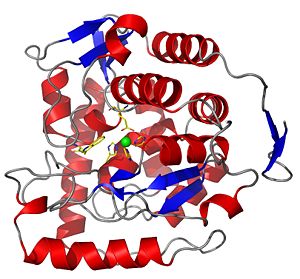The catalytic domain of chicken tryptophan hydroxylase 1 with bound tryptophan
Tryptophan hydroxylase is an iron and tetrahydrobiopterin dependent monooxygenase which belongs to the enzyme family of aromatic amino acid hydroxylases.
The structure presented here is of the catalytic domain of chicken tryptophan hydroxylase 1 with bound tryptophan substrate.
Tryptophan binding
The is bound in a binding pocket distinct from the tetrahydrobiopterin binding pocket. Hydrogen bonds between tryptophan and TPH are shown by dashed lines and hydrophobic interactions with the semi-circled residues. For residues that are not conserved in phenylalanine hydroxylase (PAH) and tyrosine hydroxylase (TH) the corresponding residues are shown.

The substrate specificity of TPH1 has been studied previously. These studies have shown that the substrate specificity i mainly controlled by
[1] and [2] [3]. Tyr236 is also involved in as seen in the structure of human TPH1 (1mlw) and in the binding of tryptophan, as seen in this structure. Phe314 is a smaller amino acid than the corresponding tryptophan seen in TH and PAH. Phenylalanine instead of tryptophan at position 314 results in a larger binding cavity in TPH with room for the tryptophan substrate.
Structural changes upon tryptophan binding
When comparing the structure of chicken TPH1 with structure of the human TPH1 with bound (entry 1mlw), large structural changes are observed. These structural changes can be understood as the enzyme closing around the active site when tryptophan is bound. The structural changes are illustrated in the figure below showing the structural alignment of two TPH1 structures (3e2t and 1mlw). The positions of Leu130 and Ile366 are shown in the two structures. These two amino acids are positioned on the two loops that move toward each other when tryptophan binds. This movement reduces the distance between the two amino acids by 10 Å.

Crystal structures of phenylalanine hydroxylase have been solved with a substrate analogue and tetrahydrobiopterin (entry 1mmk). This structure shows the same compactness as the chicken TPH1 structure with an root mean square deviation of 0.94 Å. In comparison the chicken TPH1 and human TPH1 structure has an r.m.s.d. of 1.47 Å.
Iron coordination
The by 2 histidines, one glutamate and one imidazole from the solvent.
This coordination is called the 2-histidine-1-glutamate facial triad iron coordination and is seen in many mononuclear non-heme iron(II)enzymes[4]. In this structure Glu317 coordinates the iron in a partial bidentate manner. The more common (the resting state) for the 2-His-1-Glu iron coordination is seen in the structure of human TPH1 (1mlw).
Imidazole binding
The is bound to the iron and to the protein chain through two brigding water molecules. The first water molecule makes hydrogen bonds to Gly235 and to Leu237 while the other water molecule makes hydrogen bonds to His252 and Glu274. This binding is similar to the binding in structure of the catalytic domain of human TPH1 (1mlw).
Publication Abstract from PubMed
Tryptophan hydroxylase (TPH) is a mononuclear non-heme iron enzyme, which catalyzes the reaction between tryptophan, O 2, and tetrahydrobiopterin (BH 4) to produce 5-hydroxytryptophan and 4a-hydroxytetrahydrobiopterin. This is the first and rate-limiting step in the biosynthesis of the neurotransmitter and hormone serotonin (5-hydroxytryptamine). We have determined the 1.9 A resolution crystal structure of the catalytic domain (Delta1-100/Delta415-445) of chicken TPH isoform 1 (TPH1) in complex with the tryptophan substrate and an iron-bound imidazole. This is the first structure of any aromatic amino acid hydroxylase with bound natural amino acid substrate. The iron coordination can be described as distorted trigonal bipyramidal coordination with His273, His278, and Glu318 (partially bidentate) and one imidazole as ligands. The tryptophan stacks against Pro269 with a distance of 3.9 A between the iron and the tryptophan Czeta3 atom that is hydroxylated. The binding of tryptophan and maybe the imidazole has caused the structural changes in the catalytic domain compared to the structure of the human TPH1 without tryptophan. The structure of chicken TPH1 is more compact, and the loops of residues Leu124-Asp139 and Ile367-Thr369 close around the active site. Similar structural changes are seen in the catalytic domain of phenylalanine hydroxylase (PAH) upon binding of substrate analogues norleucine and thienylalanine to the PAH.BH 4 complex. In fact, the chicken TPH1.Trp.imidazole structure resembles the PAH.BH 4.thienylalanine structure more (root-mean-square deviation for Calpha atoms of 0.90 A) than the human TPH1 structure (root-mean-square deviation of 1.47 A).
Crystal Structure of Tryptophan Hydroxylase with Bound Amino Acid Substrate., Windahl MS, Petersen CR, Christensen HE, Harris P, Biochemistry. 2008 Oct 21. PMID:18937498
From MEDLINE®/PubMed®, a database of the U.S. National Library of Medicine.



